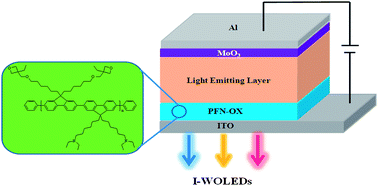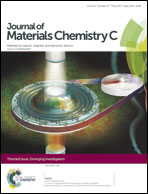High efficiency solution processed inverted white organic light emitting diodes with a cross-linkable amino-functionalized polyfluorene as a cathode interlayer
Abstract
Highly efficient inverted white organic light emitting diodes (IWOLEDs) were achieved by a simple solution processing technique, in which cross-linkable amino-functionalized polyfluorene poly[9,9-bis(6′-(N,N-diethylamino)hexyl)-fluorene-alt-9,9-bis(3-ethyl(oxetane-3-ethyoxy)-hexyl)-fluorene] (PFN-OX) served as electron injection/transporting layer (EIL) deposited onto indium tin oxide (ITO) directly without n-type inorganic metal oxides (MOs). The light emitting layer consisted of a (poly(N-vinylcarbazole) (PVK)/1,3-bis[(4-tert-butylphenyl)-1,3,4-oxadiazolyl]phenylene (OXD-7) blend as host and phosphorescent iridium complexes as guests. Our results demonstrated that ITO could serve as cathode and inject electrons into the phosphorescent system directly and efficiently by using PFN-OX as single EIL. As a result, a high performance IWOLED device with Commission Internationale de L'Eclairage (CIE) coordinate of (0.35, 0.45), colour rendering index (CRI) of 70, maximum luminous efficiency (LE) of 18.1 cd A−1 and maximum power efficiency (PE) of 6.6 lm W−1 was achieved. This result provides an easy way of fabricating multilayer solution processed high efficiency IWOLEDs.

- This article is part of the themed collection: Emerging Investigators

 Please wait while we load your content...
Please wait while we load your content...